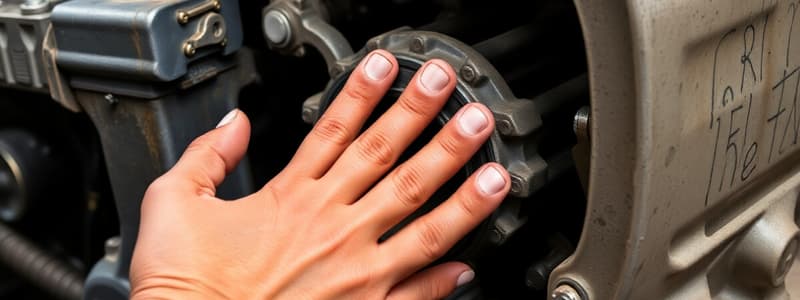Podcast
Questions and Answers
What was the cause of the crushed right little finger injury during the incident?
What was the cause of the crushed right little finger injury during the incident?
- The moonpool door ram was not properly secured. (correct)
- Workers did not perform a risk assessment.
- Inadequate protective equipment was used.
- The worker was distracted during the operation.
What is considered a key component of avoiding similar incidents in the future?
What is considered a key component of avoiding similar incidents in the future?
- Conducting regular safety drills.
- Providing individual safety gear to every worker.
- Creating more complex risk assessment documents.
- Sharing information about incidents. (correct)
What type of injury was suffered by the worker in the incident described?
What type of injury was suffered by the worker in the incident described?
- Crushed finger resulting in a fracture. (correct)
- Severe laceration on the forearm.
- Sprained wrist due to lifting.
- Burn injury from equipment.
What did the toolbox talk fail to address adequately before the incident?
What did the toolbox talk fail to address adequately before the incident?
What is the primary focus of IMCA Safety Flashes?
What is the primary focus of IMCA Safety Flashes?
Flashcards are hidden until you start studying
Study Notes
Hand Injuries
- Hand and finger injuries are a common theme in accidents reported to IMCA
- Two examples of incidents are shared:
- A worker suffered a crushed right little finger whilst moving the moonpool door ram
- The ram was placed on a flat pallet, increasing the risk of movement
- No-one stopped to reassess the additional hazard, that the ram would move
- A crew member was lifted about 0.5m clear of the deck when a tag line attached to the slings snagged on his harness
- The worker was in a hazardous place or position without knowing it
- The crew member was lowered back safely within a few seconds
- A worker suffered a crushed right little finger whilst moving the moonpool door ram
Engine Failure and Fire
- A catastrophic failure of a diesel generator on a vessel working offshore led to an engine room fire
- The failure caused engine components to be ejected by force, starting the fire
- The Hi-Fog fixed firefighting system was activated, non-essential personnel were mustered, and onshore emergency response teams were assembled
- The fire was extinguished with limited damage to any further machinery
- No-one was harmed
- The vessel subsequently left the field for a port call before undertaking extensive dry dock repairs
- Findings
- The Hi-Fog fixed firefighting system worked well
- Fire-suits and associated equipment provided good protection from heat and fire
- The offshore vessel management team and the emergency teams onboard demonstrated effective leadership in managing their response
- Lessons
- A Thermal Imaging Camera could be useful in supporting firefighting teams
- Ensure that persons on emergency response teams are familiar with all applicable emergency procedures
- Introduce fire booklets at each fire station to give details on the general layout, equipment, search routes, isolations, length of hose runs of each major area or compartment of concern
- Review and revise emergency response plans to ensure that shore-based management are informed at the earliest opportunity
BSEE: Welding and Burning Hazards
- The Bureau of Safety and Environmental Enforcement (BSEE) has released Safety Alert 482 entitled Risk Based Inspection Identifies Welding and Burning Hazards
- Following inspections on production and well operation sites in the Gulf of Mexico, BSEE discovered multiple high potential fires associated with welding and burning operations
- Several critical issues were identified requiring attention to ensure the safety and integrity of ongoing operations
- In one incident, evidence suggests hot slag from a cutting torch pierced the underside blanket barrier of the living quarters building, this caused the wood subfloor to ignite
- Inspections revealed:
- Hot work being conducted close (less than 10m) from equipment containing hydrocarbons
- Inadequate housekeeping practices, with material like cardboard boxes found within 10m of hot work areas
- Tools for fire prevention, such as fire extinguishers and portable gas detectors, not properly identified as necessary
- Offshore personnel not following safe welding and hot work procedures
- Inconsistent and infrequent training for personnel engaged in hot work and/or welding; persons without training or coding to the appropriate industry standard, were engaging in hot work
- Hot work permits and Job Safety Analyses (JSAs) listing the same person to perform fire watch and perform the hot work!
- BSEE Recommendations
- Ensure there are no flammable materials or hydrocarbons or other fire hazards nearby when preparing for hot work
- Ensure the rating, current condition, and placement of fire protection barriers mitigate the potential risk caused by hot work, including personal protective equipment
- Ensure a heightened level of planning specific to the hazards associated with welding and burning operations
- Check that training and competence requirements for persons doing hot work are in place and that they meet appropriate industry standards
- Hot work operations should be inspected by someone in charge before starting work; adequate supervision and fire watches should be in place throughout
- Ensure that all persons involved in hot work attend and participate in pre-job JSA meetings and toolbox talks and that they fully understand what is required of them.
Studying That Suits You
Use AI to generate personalized quizzes and flashcards to suit your learning preferences.




